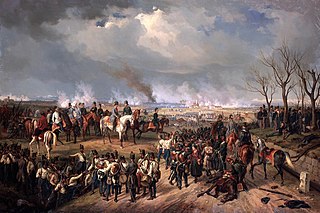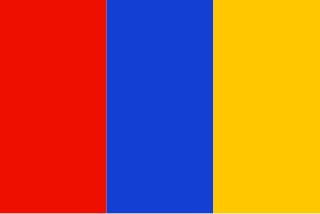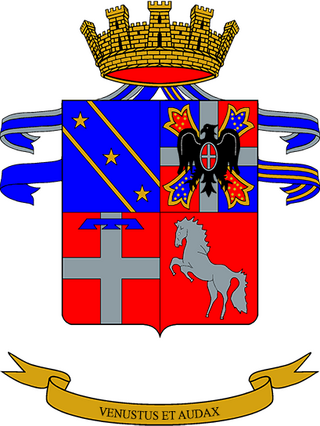
The War of the Second Coalition was the second war on revolutionary France by most of the European monarchies, led by Britain, Austria and Russia, and including the Ottoman Empire, Portugal, Naples and various German monarchies. Prussia did not join this coalition, and Spain supported France.

The Roman Republic was a sister republic of the First French Republic. It was proclaimed on 15 February 1798 after Louis-Alexandre Berthier, a general of Napoleon, had occupied the city of Rome on 10 February. It was led by a Directory of five men and comprised territory conquered from the Papal States. Pope Pius VI was exiled to France and died there in August 1799. The republic immediately took control of the other two former-papal revolutionary administrations, the Tiberina Republic and the Anconine Republic. The Roman Republic proved short-lived, as Neapolitan troops restored the Papal States in October 1799.

The Italian campaigns of the French Revolutionary Wars (1792–1802) were a series of conflicts fought principally in Northern Italy between the French Revolutionary Army and a Coalition of Austria, Russia, Piedmont-Sardinia, and a number of other Italian states.

The Battle of Novara was one of the battles fought between the Austrian Empire and the Kingdom of Sardinia during the First Italian War of Independence, within the era of Italian unification. Lasting the whole day of 22 March 1849 and ending at dawn on 23 March, it resulted in a severe defeat and retreat of the Piedmontese (Sardinian) army.

The Republic of Alba was a revolutionary municipality proclaimed on 26 April 1796, in Alba, Piedmont, when the town was taken by the French army. The municipality had a very short life of only 2 days because, with the Armistice of Cherasco on 28 April 1796, King Victor Amadeus III of Sardinia was given back the civil control of all Piedmont.

A sister republic was a republic established by French armies or by local revolutionaries and assisted by the First French Republic during the French Revolutionary Wars. These republics, though nominally independent, relied heavily on France for protection, making them more akin to autonomous territories rather than independent states. This became particularly evident after the declaration of the French Empire, when several states were annexed, and the remaining turned into monarchies ruled by members of the Bonaparte family.

The Subalpine Republic was a short-lived republic that existed between 1800 and 1802 on the territory of Piedmont during its military rule by Napoleonic France.

The Battle of Mondovì was fought on 21 April 1796 between the French army of Napoleon Bonaparte and the army of the Kingdom of Sardinia-Piedmont led by Michelangelo Alessandro Colli-Marchi. The French victory meant that they had put the Ligurian Alps behind them, while the plains of Piedmont lay before them. A week later, King Victor Amadeus III sued for peace, taking his kingdom out of the First Coalition. The defeat of their Sardinian ally wrecked the Austrian Habsburg strategy and led to the loss of northwest Italy to the First French Republic.

The Italian and Swiss expedition of 1799 was a military campaign undertaken by a combined Austro-Russian army under overall command of the Russian Marshal Alexander Suvorov against French forces in Piedmont and Lombardy and the Helvetic Republic. The expedition was part of the Italian campaigns of the French Revolutionary Wars in general, and the War of the Second Coalition in particular. It was one of 'two unprecedented Russian interventions in 1799', the other being the Anglo-Russian invasion of Holland.

The Republic of San Marco or the Venetian Republic was an Italian revolutionary state which existed for 17 months in 1848–1849. Based on the Venetian Lagoon, it extended into most of Venetia, or the Terraferma territory of the Republic of Venice, suppressed 51 years earlier in the French Revolutionary Wars. After declaring independence from the Habsburg Austrian Empire, the republic later joined the Kingdom of Sardinia in an attempt, led by the latter, to unite northern Italy against foreign domination. But the First Italian War of Independence ended in the defeat of Sardinia, and Austrian forces reconquered the Republic of San Marco on 28 August 1849 following a long siege.

The Kingdom of Sardinia, also referred to as the Kingdom ofSardinia-Piedmont or Piedmont-Sardinia during the Savoyard period, was a state in Southern Europe from the early 14th until the mid-19th century.

The Montenotte campaign began on 10 April 1796 with an action at Voltri and ended with the Armistice of Cherasco on 28 April. In his first army command, Napoleon Bonaparte's French army separated the army of the Kingdom of Sardinia-Piedmont under Michelangelo Alessandro Colli-Marchi from the allied Habsburg army led by Johann Peter Beaulieu. The French defeated both Habsburg and Sardinian armies and forced Sardinia to quit the First Coalition. The campaign formed part of the Wars of the French Revolution. Montenotte Superiore is located at the junction of Strada Provinciale 12 and 41 in the Liguria region of northwest Italy, 15 kilometres (9 mi) northeast of Carcare municipality. However, the fighting occurred in an area from Genoa on the east to Cuneo on the west.

The Second Battle of Saorgio was fought from 24 to 28 April 1794 between a French First Republic army commanded by Pierre Jadart Dumerbion and the armies of the Kingdom of Sardinia-Piedmont and the Habsburg monarchy led by Joseph Nikolaus De Vins. It was part of a successful French offensive designed to capture strategic positions in the Maritime Alps and Ligurian Alps, and on the Mediterranean coast. Tactical control of the battle was exercised by André Masséna for the French and Michelangelo Alessandro Colli-Marchi for the Coalition. Saorge is located in France, about 70 kilometres (43 mi) northeast of Nice. At the time of the battle, the town was named Saorgio and belonged to Piedmont.

The flag of Piedmont is one of the official symbols of the region of Piedmont in Italy. The current flag was adopted on 24 November 1995.

The 1st Regiment "Granatieri di Sardegna" is an active unit of the Italian Army based in Rome in Lazio. The regiment is part of the army's infantry arm's Granatieri (Grenadiers) speciality and assigned to the Mechanized Brigade "Granatieri di Sardegna". Formed in 1659 the regiment is the currently oldest active unit of the Italian Army and the most senior regiment in the Italian Army's infantry order of precedence. Together with its sister the regiment, the 2nd Regiment "Granatieri di Sardegna", the regiment is the guard regiment of Rome.

The Regiment "Nizza Cavalleria" (1st) is a cavalry unit of the Italian Army based in Bellinzago Novarese in Piedmont. The regiment is the reconnaissance unit of the Alpine Brigade "Taurinense".

The Regiment "Piemonte Cavalleria" (2nd) is a cavalry regiment of the Italian Army based in Villa Opicina in Friuli Venezia Giulia.The regiment is the reconnaissance unit of the Alpine Brigade "Julia".

The Regiment "Genova Cavalleria" (4th) is a cavalry unit of the Italian Army based in Palmanova in Friuli Venezia Giulia. The regiment is the highest decorated and oldest cavalry regiment of the Italian Army and the only army unit, whose anniversary commemorates a pre-Risorgimento event. The regiment is the reconnaissance unit of the Cavalry Brigade "Pozzuolo del Friuli".

The Kingdom of Sardinia, also referred to as the Kingdom ofSardinia-Piedmont or Piedmont-Sardinia during the Savoyard period, was a state in Southern Europe from the early 14th until the mid-19th century.























